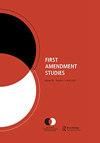Circumventing the “true threat” and “viewpoint” protection tests to deal with persistent campus hate speech
Q2 Social Sciences
引用次数: 4
Abstract
ABSTRACT This essay suggests using harassment law as a mechanism for remedying defects in “true threat” and “viewpoint protection” language which places an undue burden of proof on those trying to quell hate speech on campuses. The essay reviews noted failures and their causes in “true threat” and “viewpoint protection” rulings. Currently, the First Amendment of the Constitution protects freedom of expression unless it presents “a clear and present danger,” is treasonous, obscene, libelous or slanderous. The initial “clear and present danger” standard laid out by Justice Holmes in the Schenck decision has been refined in several cases to create an even heavier burden of proof. Currently, based particularly on the Brandenburg v. Ohio and Virginia v. Black rulings, to be prosecutable, speech must be a “true threat,” which means person-specific, imminent, and possible. However, the Supreme Court has also protected hate speech by defining it as “viewpoint” in such case as Indiana v. Hess, Snyder v. Phelps, and Matal v. Tam. This essay concludes by exploring ways to circumvent the “true threat” and “viewpoint” standards by relying on harassment rulings and extending these precedents from the workplace to campus learning environments.规避“真实威胁”和“观点”保护测试,应对持续存在的校园仇恨言论
摘要本文建议使用骚扰法作为一种机制来弥补“真实威胁”和“观点保护”语言中的缺陷,这些缺陷使那些试图平息校园仇恨言论的人承担了不当的举证责任。这篇文章回顾了在“真正威胁”和“观点保护”裁决中注意到的失败及其原因。目前,宪法第一修正案保护言论自由,除非它呈现出“明确而现实的危险”,是叛国、淫秽、诽谤或诽谤。霍姆斯大法官在申克案判决中提出的最初的“明确而现实的危险”标准,在几起案件中得到了改进,从而产生了更重的举证责任。目前,特别是根据勃兰登堡诉俄亥俄州案和弗吉尼亚诉布莱克案的裁决,言论必须是“真正的威胁”,这意味着针对个人的、迫在眉睫的和可能的。然而,在印第安纳诉赫斯案、斯奈德诉菲尔普斯案和马塔尔诉塔姆案等案件中,最高法院也通过将仇恨言论定义为“观点”来保护仇恨言论。本文最后探讨了通过依赖骚扰裁决和将这些先例从工作场所扩展到校园学习环境来规避“真正威胁”和“观点”标准的方法。
本文章由计算机程序翻译,如有差异,请以英文原文为准。
求助全文
约1分钟内获得全文
求助全文
来源期刊

First Amendment Studies
Social Sciences-Law
自引率
0.00%
发文量
0
期刊介绍:
First Amendment Studies publishes original scholarship on all aspects of free speech and embraces the full range of critical, historical, empirical, and descriptive methodologies. First Amendment Studies welcomes scholarship addressing areas including but not limited to: • doctrinal analysis of international and national free speech law and legislation • rhetorical analysis of cases and judicial rhetoric • theoretical and cultural issues related to free speech • the role of free speech in a wide variety of contexts (e.g., organizations, popular culture, traditional and new media).
 求助内容:
求助内容: 应助结果提醒方式:
应助结果提醒方式:


